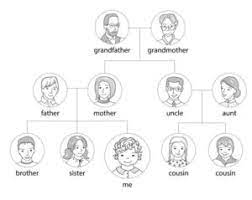Unveiling Your Roots: Embark on a Journey to Discover Your Family Tree
Discover Your Family Tree: Unraveling the Secrets of Your Ancestry
Have you ever wondered about the stories and mysteries that lie within your family’s history? Who were your ancestors? Where did they come from? What adventures, triumphs, and challenges did they experience? Discovering your family tree can be an exciting journey of self-discovery and a fascinating exploration of the past.
Unraveling the secrets of your ancestry begins with building your family tree. It’s like putting together a puzzle, piece by piece, as you trace back through generations. Each new branch you uncover adds depth and richness to your understanding of who you are and where you come from.
The first step in building your family tree is to gather information from living relatives. Speak with parents, grandparents, aunts, uncles, and cousins to collect names, dates, locations, and stories. These personal accounts are invaluable in piecing together the puzzle of your family’s history.
With this initial information in hand, it’s time to dive into historical records. Online databases, local archives, libraries, and government offices hold a treasure trove of documents that can help fill in the gaps. Birth certificates, marriage records, census data, immigration records – all provide clues that connect the dots between generations.
As you delve deeper into your research journey, be prepared for surprises along the way. You may uncover long-lost relatives or discover connections to historical events that shaped the lives of your ancestors. These revelations add layers of intrigue to your family story.
Technology has revolutionized genealogical research. Numerous websites offer tools and platforms specifically designed to assist in building family trees. These platforms allow you to organize information efficiently while also providing access to vast databases that can help expand your research further.
However, it’s important to approach genealogy with a critical eye. Not all information found online is accurate, and it’s crucial to verify facts through multiple sources. Collaborating with other genealogists and joining genealogical societies can provide valuable insights and guidance as you navigate the intricate world of family history.
Discovering your family tree is not just about names and dates; it’s about connecting with your roots, understanding your heritage, and preserving the stories of those who came before you. It allows you to honor their legacies and pass down this knowledge to future generations.
So, embark on this captivating journey of self-discovery. Unravel the secrets of your ancestry, piece by piece, as you build your family tree. With each new branch added, you’ll gain a deeper appreciation for the diverse tapestry that makes up your unique identity.
Exploring Your Ancestry: A Guide to Free Family Tree Research and the World’s Oldest Bloodlines
- Is FamilySearch totally free?
- What is the oldest bloodline in the world?
- How can I find my family tree without paying?
- What is the best website to look up family history?
Is FamilySearch totally free?
Yes, FamilySearch is indeed a free genealogy website that provides access to a vast collection of historical records, family trees, and other resources. Whether you’re just starting your journey to discover your family tree or you’re an experienced genealogist, FamilySearch offers a wealth of information at no cost. From birth and marriage certificates to census records and immigration documents, this platform allows users to explore their ancestry without any subscription fees or hidden charges. With its commitment to making genealogical research accessible to all, FamilySearch has become a valuable resource for individuals seeking to uncover the stories of their ancestors.
What is the oldest bloodline in the world?
The question of the oldest bloodline in the world is a fascinating inquiry into the ancient origins of human lineage. While it is impossible to pinpoint a single bloodline as the absolute oldest, scientists and historians have traced genetic markers and historical records to shed light on some of the oldest known lineages. These lineages often trace back to regions such as Africa, where humanity is believed to have originated tens of thousands of years ago. The study of human genetics and genealogy continues to unveil new insights into our shared ancestry, highlighting the interconnectedness of all humans throughout history.
How can I find my family tree without paying?
If you’re eager to delve into your family tree without incurring any costs, there are several avenues you can explore. Start by gathering information from living relatives and recording their stories and memories. This can provide a strong foundation for your research. Utilize free online resources such as family search websites, public databases, and social media platforms to search for records and connect with other researchers. Local libraries often offer access to genealogical resources at no charge, including books, microfilm, and online databases. Additionally, consider joining online genealogy communities where members freely share information and provide guidance. While paid services may offer additional features or access to exclusive databases, there are numerous ways to begin your family tree journey without spending a dime.
What is the best website to look up family history?
When it comes to looking up family history, there are several excellent websites available that can assist you in your genealogical journey. While the “best” website may vary depending on individual preferences and specific research needs, some popular choices among genealogists include Ancestry.com, MyHeritage, FamilySearch, and Findmypast. These platforms offer vast databases of historical records, user-friendly interfaces, and robust search functionalities to help you uncover valuable information about your ancestors. It’s recommended to explore multiple websites and consider factors such as available records, user reviews, pricing plans, and additional features to find the website that aligns best with your research objectives and budget.

